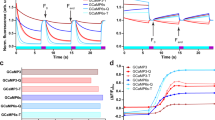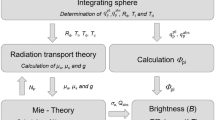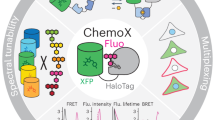Abstract
Particle-based nanosensors offer a tool for determining the pH in the endosomal-lysosomal system of living cells. Measurements providing absolute values of pH have so far been restricted by the limited sensitivity range of nanosensors, calibration challenges and the complexity of image analysis. This protocol describes the design and application of a polyacrylamide-based nanosensor (∼60 nm) that covalently incorporates two pH-sensitive fluorophores, fluorescein (FS) and Oregon Green (OG), to broaden the sensitivity range of the sensor (pH 3.1–7.0), and uses the pH-insensitive fluorophore rhodamine as a reference fluorophore. The nanosensors are spontaneously taken up via endocytosis and directed to the lysosomes where dynamic changes in pH can be measured with live-cell confocal microscopy. The most important focus areas of the protocol are the choice of pH-sensitive fluorophores, the design of calibration buffers, the determination of the effective range and especially the description of how to critically evaluate results. The entire procedure typically takes 2–3 weeks.
This is a preview of subscription content, access via your institution
Access options
Subscribe to this journal
Receive 12 print issues and online access
$259.00 per year
only $21.58 per issue
Buy this article
- Purchase on Springer Link
- Instant access to full article PDF
Prices may be subject to local taxes which are calculated during checkout









Similar content being viewed by others
References
Casey, J.R., Grinstein, S. & Orlowski, J. Sensors and regulators of intracellular pH. Nat. Rev. Mol. Cell Biol. 11, 50–61 (2010).
Barry, M., Reynolds, J. & Eastman, A. Etoposide-induced apoptosis in human Hl-60 cells is associated with intracellular acidification. Cancer Res. 53, 2349–2357 (1993).
Kornak, U. et al. Impaired glycosylation and cutis laxa caused by mutations in the vesicular H+-ATPase subunit ATP6V0A2. Nat. Genet. 40, 32–34 (2008).
Jahn, R., Lang, T. & Sudhof, T. Membrane fusion. Cell 112, 519–533 (2003).
Maxfield, F.R. & McGraw, T.E. Endocytic recycling. Nat. Rev. Mol. Cell Biol. 5, 121–132 (2004).
Hunte, C. et al. Structure of a Na+/H+ antiporter and insights into mechanism of action and regulation by pH. Nature 435, 1197–1202 (2005).
Andresen, T.L., Jensen, S.S. & Jorgensen, K. Advanced strategies in liposomal cancer therapy: problems and prospects of active and tumor-specific drug release. Prog. Lipid Res. 44, 68–97 (2005).
Bradley, M. et al. pH sensing in living cells using fluorescent microspheres. Bioorg. Med. Chem. Lett. 18, 313–317 (2008).
Lapresta-Fernandez, A. et al. Magnetic core-shell fluorescent pH ratiometric nanosensor using a Stober coating method. Anal. Chim. Acta 707, 164–170 (2011).
Hornig, S. et al. Biocompatible fluorescent nanoparticles for pH-sensoring. Soft Matter 4, 1169–1172 (2008).
Doussineau, T., Smaihi, M. & Mohr, G.J. Two-dye core/shell zeolite nanoparticles: a new tool for ratiometric pH measurements. Adv. Funct. Mater. 19, 117–122 (2009).
Benjaminsen, R.V. et al. Evaluating nanoparticle sensor design for intracellular pH measurements. ACS Nano 5, 5864–5873 (2011).
Sun, H., Almdal, K. & Andresen, T.L. Expanding the dynamic measurement range for polymeric nanoparticle pH sensors. Chem. Commun. 47, 5268–5270 (2011).
Kulichikhin, K.Y., Aitio, O., Chirkova, T.V. & Fagerstedt, K.V. Effect of oxygen concentration on intracellular pH, glucose-6-phosphate and NTP content in rice (Oryza sativa) and wheat (Triticum aestivum) root tips: in vivo P-31-NMR study. Physiol. Plantarum 129, 507–518 (2007).
Sommer, S., Jahn, A., Funke, F. & Brenke, N. In vivo measurements of the internal pH of Hediste (Nereis) diversicolor (Annelida, Polychaeta) exposed to ambient sulphidic conditions using pH microelectrodes. Naturwissenschaften 87, 283–287 (2000).
Kneipp, J., Kneipp, H., Wittig, B. & Kneipp, K. Novel optical nanosensors for probing and imaging live cells. Nanomedicine 6, 214–226 (2010).
Han, J. & Burgess, K. Fluorescent indicators for intracellular pH. Chem. Rev. 110, 2709–2728 (2010).
Li, X., Gao, X., Shi, W. & Ma, H. Design strategies for water-soluble small molecular chromogenic and fluorogenic probes. Chem. Rev. 114, 590–659 (2014).
Myochin, T. et al. Rational design of ratiometric near-infrared fluorescent pH probes with various pKa values, based on aminocyanine. J. Am. Chem. Soc. 133, 3401–3409 (2011).
Gan, B.S., Krump, E., Shrode, L.D. & Grinstein, S. Loading pyranine via purinergic receptors or hypotonic stress for measurement of cytosolic pH by imaging. Am. J. Physiol. 275, C1158–C1166 (1998).
Bizzarri, R., Serresi, M., Luin, S. & Beltram, F. Green fluorescent protein based pH indicators for in vivo use: a review. Anal. Bioanal. Chem. 393, 1107–1122 (2009).
Clark, H.A., Kopelman, R., Tjalkens, R. & Philbert, M.A. Optical nanosensors for chemical analysis inside single living cells. 2. Sensors for pH and calcium and the intracellular application of PEBBLE sensors. Anal. Chem. 71, 4837–4843 (1999).
Dennis, A.M., Rhee, W.J., Sotto, D., Dublin, S.N. & Bao, G. Quantum dot-fluorescent protein FRET probes for sensing intracellular pH. ACS Nano 6, 2917–2924 (2012).
Modi, S. et al. A DNA nanomachine that maps spatial and temporal pH changes inside living cells. Nat. Nanotechnol. 4, 325–330 (2009).
Mellman, I., Fuchs, R. & Helenius, A. Acidification of the endocytic and exocytic pathways. Annu. Rev. Biochem. 55, 663–700 (1986).
Luzio, J.P., Pryor, P.R. & Bright, N.A. Lysosomes: fusion and function. Nat. Rev. Mol. Cell Biol. 8, 622–632 (2007).
Su, M.H. et al. 1,9-Dihydro-3-phenyl-4H-pyrazolo[3,4-b]quinolin-4-one, a novel fluorescent probe for extreme pH measurement. Chem. Commun. 11, 960–961 (2001).
Schulz, A. et al. Evaluation of fluorescent polysaccharide nanoparticles for pH-sensing. Org. Biomol. Chem. 7, 1884–1889 (2009).
Lee, R.J., Wang, S. & Low, P.S. Measurement of endosome pH following folate receptor-mediated endocytosis. Biochim. Biophys. Acta 1312, 237–242 (1996).
Sun, H., Benjaminsen, R.V., Almdal, K. & Andresen, T.L. Hyaluronic acid immobilized polyacrylamide nanoparticle sensors for CD44 receptor targeting and pH measurement in cells. Bioconjug. Chem. 23, 2247–2255 (2012).
Coupland, P.G., Briddon, S.J. & Aylott, J.W. Using fluorescent pH-sensitive nanosensors to report their intracellular location after Tat-mediated delivery. Integr. Biol. 1, 318–323 (2009).
Disbrow, G.L., Hanover, J.A. & Schlegel, R. Endoplasmic reticulum-localized human papillomavirus type 16 E5 protein alters endosomal pH but not trans-Golgi pH. J. Virol. 79, 5839–5846 (2005).
Jankowski, A. et al. In situ measurements of the pH of mammalian peroxisomes using the fluorescent protein pHluorin. J. Biol. Chem. 276, 48748–48753 (2001).
Llopis, J., McCaffery, J.M., Miyawaki, A., Farquhar, M.G. & Tsien, R.Y. Measurement of cytosolic, mitochondrial, and Golgi pH in single living cells with green fluorescent proteins. Proc. Natl. Acad. Sci. USA 95, 6803–6808 (1998).
Yue, Z. et al. Surface charge affects cellular uptake and intracellular trafficking of chitosan-based nanoparticles. Biomacromolecules 12, 2440–2446 (2011).
Benjaminsen, R.V., Mattebjerg, M.A., Henriksen, J.R., Moghimi, S.M. & Andresen, T.L. The possible “proton sponge” effect of polyethylenimine (PEI) does not include change in lysosomal pH. Mol. Ther. 21, 149–157 (2013).
Doussineau, T., Trupp, S. & Mohr, G.J. Ratiometric pH-nanosensors based on rhodamine-doped silica nanoparticles functionalized with a naphthalimide derivative. J. Colloid Interface Sci. 339, 266–270 (2009).
Borisov, S.M., Herrod, D.L. & Klimant, I. Fluorescent poly(styrene-block-vinylpyrrolidone) nanobeads for optical sensing of pH. Sens. Actuators B 139, 52–58 (2009).
McNamara, K.P. et al. Synthesis, characterization, and application of fluorescence sensing lipobeads for intracellular pH measurements. Anal. Chem. 73, 3240–3246 (2001).
Aylott, J. Optical nanosensors: an enabling technology for intracellular measurements. Analyst 128, 309–312 (2003).
Buck, S.M. et al. Optochemical nanosensor PEBBLEs: photonic explorers for bioanalysis with biologically localized embedding. Curr. Opin. Chem. Biol. 8, 540–546 (2004).
Sun, H., Andresen, T.L., Benjaminsen, R.V. & Almdal, K. Polymeric nanosensors for measuring the full dynamic pH range of endosomes and lysosomes in mammalian cells. J. Biomed. Nanotechnol. 5, 676–682 (2009).
Domingos, R.F. et al. Characterizing manufactured nanoparticles in the environment: multimethod determination of particle sizes. Environ. Sci. Technol. 43, 7277–7284 (2009).
Peng, J. et al. Noninvasive monitoring of intracellular pH change induced by drug stimulation using silica nanoparticle sensors. Anal. Bioanal. Chem. 388, 645–654 (2007).
Stone, V., Johnston, H. & Schins, R.P. Development of in vitro systems for nanotoxicology: methodological considerations. Crit. Rev. Toxicol. 39, 613–626 (2009).
Kroll, A., Pillukat, M.H., Hahn, D. & Schnekenburger, J. Current in vitro methods in nanoparticle risk assessment: limitations and challenges. Eur. J. Pharm. Biopharm. 72, 370–377 (2009).
Acknowledgements
This work was financially supported by the Danish Cancer Society and the Danish Council for Independent Research (Technology and Production Sciences (FTP) grant no. 274-07-0172). We furthermore thank H. Sun and E.K.P. Kumar (Technical University of Denmark, Denmark) for synthesis of the nanosensors.
Author information
Authors and Affiliations
Contributions
R.V.S., J.R.H. and T.L.A. developed the protocol and analyzed the results. R.V.S. and T.L.A. designed the experiments and wrote the paper. R.V.S. performed all the experiments. J.R.H. wrote the code for image analysis.
Corresponding author
Ethics declarations
Competing interests
The authors declare no competing financial interests.
Integrated supplementary information
Supplementary Figure 1 Three different calibration types of the nanosensor.
Calibration in buffer was performed in pure buffer as described in the main protocol. Calibration in artificial cytoplasm and with nigericin was performed as described in BOX 3. Briefly; artificial cytoplasm was prepared by sonication of HeLa cells and mixed with buffers with controlled pH. In situ calibration with nigericin was performed by treatment of nanosensor-containing cells with nigericin in K+-rich buffers. Mean ± SD between three images are presented. Reproduced with permission from Benjaminsen et al. (Evaluating Nanoparticle Sensor Design for Intracellular pH Measurements. ACS Nano 5, 5864-5873 (2011)). Copyright 2011 American Chemical Society.
Supplementary information
Supplementary Figure 1
Three different calibration types of the nanosensor. (PDF 75 kb)
Supplementary Discussion
Potential expansion of the protocol to measure other metabolites. (PDF 105 kb)
Rights and permissions
About this article
Cite this article
Søndergaard, R., Henriksen, J. & Andresen, T. Design, calibration and application of broad-range optical nanosensors for determining intracellular pH. Nat Protoc 9, 2841–2858 (2014). https://doi.org/10.1038/nprot.2014.196
Published:
Issue Date:
DOI: https://doi.org/10.1038/nprot.2014.196
This article is cited by
-
Dual color pH probes made from silica and polystyrene nanoparticles and their performance in cell studies
Scientific Reports (2023)
-
pH-gated nanoparticles selectively regulate lysosomal function of tumour-associated macrophages for cancer immunotherapy
Nature Communications (2023)
-
Fluorescent nanosensors reveal dynamic pH gradients during biofilm formation
npj Biofilms and Microbiomes (2021)
-
Fluorescent Silicon-based Nanomaterials Imaging Technology in Diseases
Chemical Research in Chinese Universities (2021)
-
Upconversion nanoparticles as intracellular pH messengers
Analytical and Bioanalytical Chemistry (2020)
Comments
By submitting a comment you agree to abide by our Terms and Community Guidelines. If you find something abusive or that does not comply with our terms or guidelines please flag it as inappropriate.



